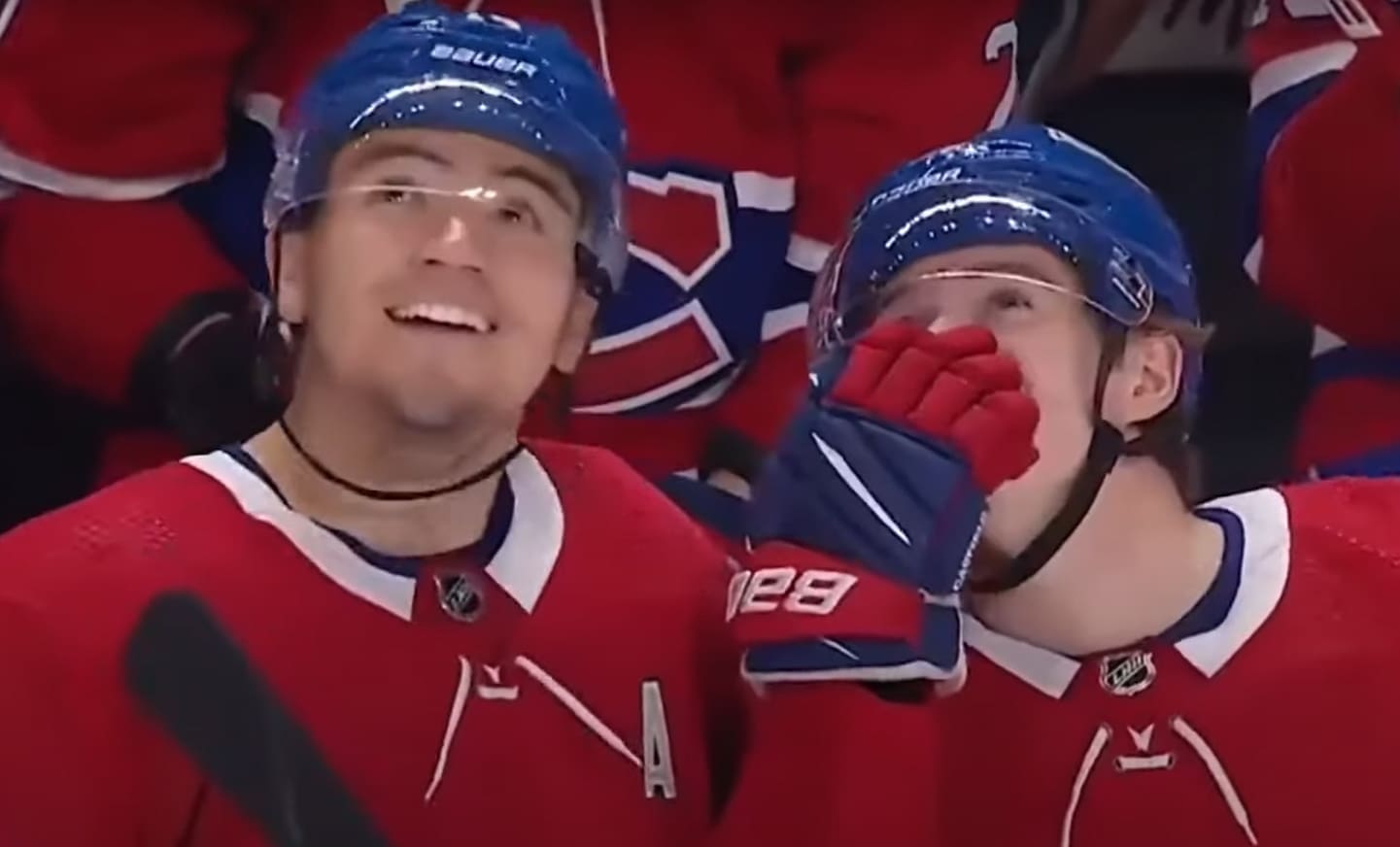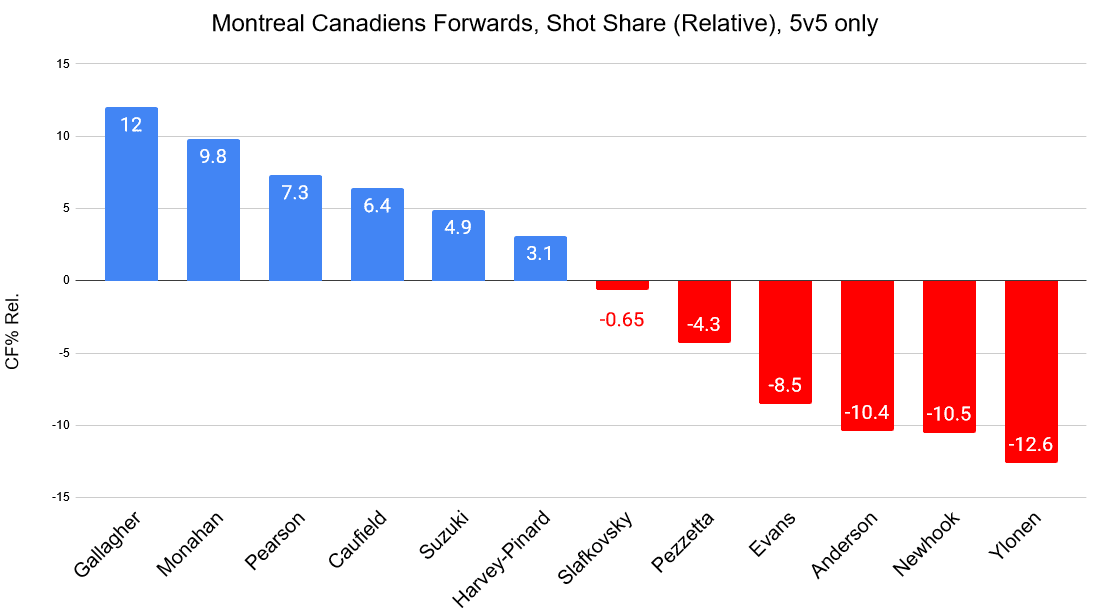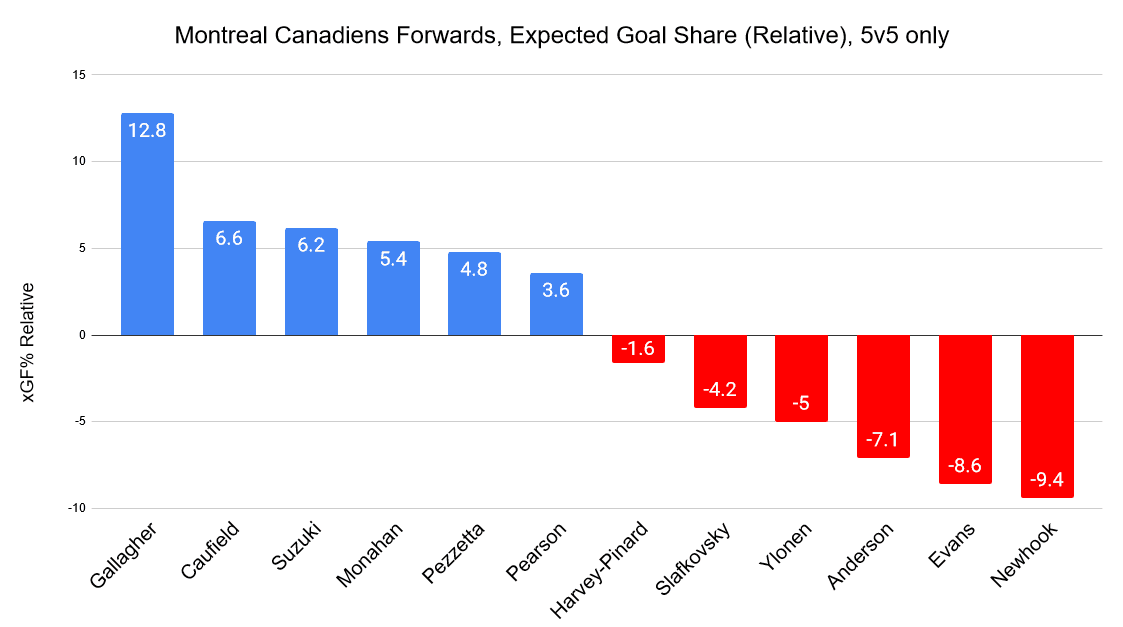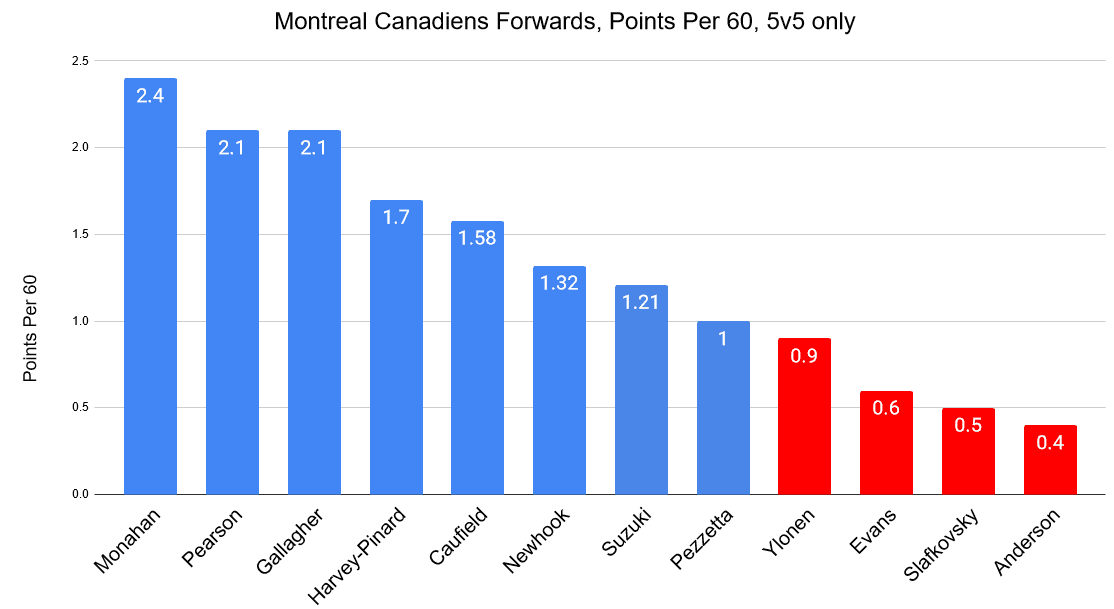Canadiens Analysis
Habs Stat Pack: The Top Line’s Important Change For Canadiens

Now that the Montreal Canadiens have completed almost 15 percent of their season, it’s time to take another look at some of the underlying numbers produced by the various forwards in the lineup.
Habs Shot Share
Why is it important to monitor shot share (CF%)?
It gives us a better idea of which team controls the puck when particular players are on the ice. As we all know, controlling shots tends to lead to goals, and that’s how you win hockey games.
Think of it this way, it’s a modernized version of the adage “Put the puck on the net, and good things will happen”. We will be using relative statistics, which measure a player’s impact relative to their teammates.
When evaluating shot share, one thing is evident: two lines have done a great job this season, while the other two lines have struggled mightily.
The Brendan Gallagher, Sean Monahan, and Tanner Pearson line has been excellent, as has the top line, which featured Nick Suzuki, Rafael Harvey-Pinard, and Cole Caufield.
Sean Monahan SZN continues, and it's glorious.
Good work by Gallagher to start the breakout, and solid positioning by Pearson to create chaos.
1-0 #Habs pic.twitter.com/W1GYRRroPr
— Marc Dumont (@MarcPDumont) November 3, 2023
Juraj Slafkovsky has distanced himself from the rest of the second line thanks to his two games alongside Kirby Dach to start the season, as well as his lone game on the top line on Saturday.
You could also argue that Michael Pezzetta has done better than his linemates, Jake Evans and Jesse Ylonen.
As for Josh Anderson and Alex Newhook, things have not gone according to plan. They’re getting outplayed by a significant margin every night.
Once we shift to their high-danger shot share (HDCF% Rel), we see that Pezzetta has done a fantastic job controlling the quality chances while he’s on the ice. More than anything, his relative numbers are so high because opposing teams rarely get good chances during his shifts.
Harvey-Pinard and Gallagher also feature prominently in this particular metric, followed by the remaining members of the top line, as well as Monahan.
Rafael Harvey-Pinard doing what he does best: outworking his opponents and creating scoring chances out of nothing. pic.twitter.com/ycPE6FYzLc
— Marc Dumont (@MarcPDumont) October 15, 2023
The five players on the negative side of things are unsurprising, though it should be said that both Evans and Slafkovsky are much closer to breaking even than Newhook, Ylonen, and Anderson.
Descriptive Vs. Predictive Statistics
The first two metrics we discussed give us a better idea of the results, whereas expected goal share (xGF%) is a predictive statistic, meaning it gives us some insight as to how the players in question may perform in the future. It uses information such as shot locations, shot types, and more.
Once again, we see a clear distinction between two lines that are helping the team win and two lines that are holding the Montreal Canadiens back.
It should be noted that Pezzetta managed to produce a positive expected goal share, a rather impressive feat considering his usage.
Justin Barron scores AGAIN!
Goals in back-to-back games.
Great shift by Pezzetta too. Started it with a big hit. pic.twitter.com/8z1UPCNAZI
— Marc Dumont (@MarcPDumont) October 24, 2023
Unfortunately, both Newhook and Anderson are among the worst performers, owing to the lack of chemistry they’ve displayed since being used together by head coach Martin St-Louis.
Production
Using stats such as shot share, high-danger scoring chance share, and expected goals will provide us with important information, but when it comes down to it, you need to produce points to be considered a useful forward.
But not all shifts are created equal. We have to consider that the top line usually faces the opposing team’s best players, whereas the fourth line doesn’t get as many opportunities as the other trios.
To even things out to a certain extent, we can evaluate how many points the Canadiens forwards have been producing per 60 minutes of ice time.
Monahan stands out as the most productive Hab, with his linemates, Pearson and Gallagher, following suit. We then see two members of the top line round out the top 5, with Newhook finally placing among the top forwards on the team.
Alex Newhook scores his second goal of the game. Great play by Slafkovsky to keep the play alive and cancel the clearing.
4-3 #Habs lead. pic.twitter.com/B64crv4dq1
— Marc Dumont (@MarcPDumont) October 12, 2023
Suzuki’s production at 5v5 has not been great, but considering his possession metrics have been quite good, we should expect an uptick in points from the team’s captain in the near future.
Slafkovsky has clearly struggled to register his name on the scoresheet, as has Anderson.
Final Thoughts
The Montreal Canadiens have only played 11 games, which means the numbers can and will change. But we do have enough data to start drawing conclusions.
The first and most evident conclusion is that St-Louis waited too long to break up the Slafkovsky, Anderson, and Newhook line. Like a book written by Dan Brown, it’s been terrible from start to finish.
The second is that the Monahan line hasn’t just done a good job this season, they’ve been excellent. St-Louis has cut their ice time compared to previous years, and it seems to allow all three veterans to give their all during every shift without running out of energy.
And finally, we can safely say the top line has finally started producing the type of underlying numbers that would suggest they’re capable of producing sustained offence.
Nick Suzuki’s goal tonight, in his 300th game, against his former team. Inject this in my veins 💉 pic.twitter.com/iGDG5J0V7L
— HFTV (@HFTVSports) October 31, 2023
This was not the case last year unless someone like Monahan or Dach was used on the wing.
This season, not only have Suzuki and Caufield managed to produce fairly strong numbers, but they’ve also done night in and night out.
It’s easily one of the most encouraging changes in the lineup this season, and a very important step in the team’s long-term rebuild plans.
In the past, I’ve strongly suggested the duo should be separated, and their results in previous seasons support this theory, but if they can continue to score while producing strong numbers at 5v5 the Montreal Canadiens will be in much better shape.
All Montreal Canadiens Statistics are 5v5 unless otherwise noted, via Natural Stat Trick.















